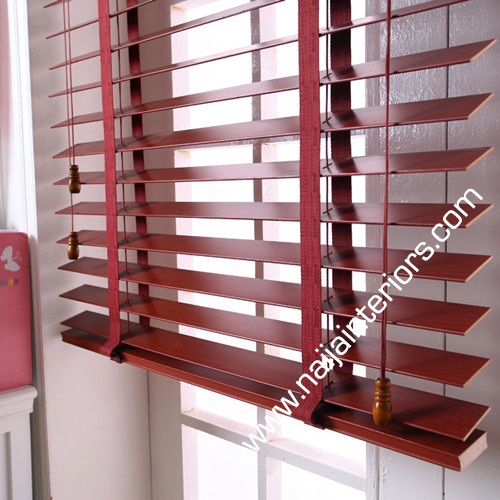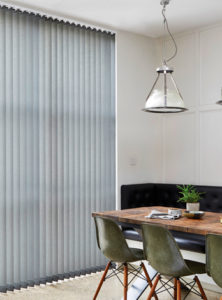WOODEN BLINDS

Wooden blinds are very easy to clean, as long as you use the right techniques and products.
Dusting is one of the quickest and most effective methods for cleaning your wooden blinds. Use a slat cleaner, feather duster or a clean, dry cloth, wiping gently downwards so as not to not disturb the slats. Wipe once when the slats are open, and again when closed. This will remove all surface dust.
You can also use a gentle suction setting on your vacuum cleaner with a soft attachment. Do not use a vacuum cleaner unless you have a soft brush attachment, as your slats may become scuffed and scratched. Clean the slats from one end to the other, taking care not to knock or disturb the arrangement. You could take your blinds down to do this, but if possible, leave them hung for ease.
Any sticky patches or grease should be rubbed gently with a clean, damp cloth. You could also use washing up liquid. Baby wipes also work well to remove these types of marks. Don’t forget to go back with a dry cloth to absorb any residue. If possible, leave your windows open during and after the cleaning process to encourage the evaporation of any residual water.
Remember, excessive moisture can cause serious damage to wooden blinds. When saturated, the wood will expand, which can then lead to bending and breaking. Any stains, varnishes and finishes on the wooden slats may also fade and peel if the wrong products are used. With that in mind, you should try to avoid liquid or chemical products when cleaning your wooden blinds.
Top takeaways:
1. Very easy to clean
2. Use a slat cleaner, feather duster or dry cloth
3. Brush attachment on vacuum works well
4. Remove stubborn stains with care
5. Avoid liquid products
DAY AND NIGHT BLINDS

Day and Night blinds are constructed from one continuous sheet of fabric. You can ensure the full surface is cleaned by completing a full rotation.
When you undertake frequent cleaning, use a feather duster or soft cloth to remove particles. Try to focus on the edges of the blind, which may collect more dust and dirt due to their contact with the window frame and windowsill.
If you own a steam cleaner, you could also try this on a low to medium setting. The steam will lift off lingering stains as well as banishing any potential mould and mildew.
You should never use your vacuum cleaner on Day and Night blinds, as the suction can fray and damage the fabric
When using chemical cleaning products, you must ensure that the area of the blind you are treating doesn’t become bleached or discoloured. And of course, bear in mind that deep cleaning specific areas may leave the rest of the blind looking grubby.
Top takeaways:
1. Be light handed when cleaning
2. Focus on the edges of the blind
3. Complete a full rotation
4. Never use your vacuum cleaner
VENETIAN BLINDS

Your aluminium or faux wood Venetian blinds will require regular cleaning to avoid dust collecting. This is due to their horizontal arrangement and metal slats, which tend to attract dust and dirt.
Place your blinds in the closed position and go over with a soft duster, wiping from the middle outwards. Now, open and close in the opposite direction, and repeat the process. If your aluminium blinds have sticky stains or grease, try a mild detergent like washing up liquid. Use a damp cloth to gently buff the mark and then pat the affected slats dry with kitchen roll. You can also use baby wipes for sticky marks and grease.
For a really thorough clean, remove your blind from the headrail and lay it down on a protective surface, like a towel or an old blanket. If the weather is nice, you can do this outside.
Fill a bowl or bucket with warm water and add a small amount of detergent. Use a soft sponge to wipe down each slat, then rinse with clean, cold water. Allow your blinds to dry naturally. If it’s not warm or sunny enough, you could use a hairdryer on the coolest setting.
Remember, you must treat your blinds differently if they are wooden Venetian blinds. This is because wood reacts very differently to metal when put into contact with liquid or chemicals. While your aluminium or faux wooden blinds can be cleaned using the above methods, you should look at our guide for cleaning wooden blinds when tackling your real wood Venetians.
Top takeaways:
1. Very easy to clean
2. Clean regularly with a damp cloth
3. Pat dry with kitchen roll
4. Remove your blinds for thorough cleaning
5. Try a hairdryer for quick results
ROLLER BLIND

It doesn’t take long to clean your roller blinds and get them looking as good as new. If you’ve purchased PVC or easy wipe roller blinds, you’re in luck – your blinds will be even more simple to clean, thanks to their water resistant and wipe-clean properties.
Keep on top of your rollers by wiping them with a clean, damp cloth. Roll all the way down and wipe from top to bottom. Allow your roller blind to dry before raising it again. You should aim to do this a couple of times a month, incorporating it into your wider cleaning routine.
Your roller blinds can be cleaned with baby wipes, as long as you rub gently so as not to remove any coating.
Clean plastic roller blind chain or cord with warm soapy water. Do not clean steel or brass chains this way, as they will become rusty over time. This is a good opportunity to check that your safety device is in place and working correctly. If not, it’s time to invest in a new chain or cord tidy, which will ensure your window treatment is child-safe. You can also clean the roller blind mechanism with a simple silicone spray, which will banish dirt as well as preventing squeaking and stiffness. Be careful when you spray and avoid contacting the actual roller blind fabric, which may react badly to the spray and could lead to bleaching or discolouration.
Top takeaways:
1. Very easy to clean
2. Clean regularly with a damp cloth
3. Use baby wipes
4. Don’t forget to clean the mechanism
VERTICAL BLINDS

Vertical blinds require very little maintenance due to their long, downwards-hanging louvres. This means they are less likely to collect dust, as there’s very little area for it to settle.
Most vertical blinds are constructed from flexible polyester or similar, which makes them easily wipe-clean with a clean, damp cloth.
If you want to undertake a thorough clean and concentrate on each louvre individually, it may be easier to unclip and remove your vertical blinds from the rail.
You should always dry your vertical blinds naturally to maintain their shape, size and colour. If your louvres have been thoroughly saturated in the cleaning process, do not hang them to dry, as this will cause the water to settle at the bottom of the fabric. Instead, lay each louvre down on a clean flat surface and allow them to dry naturally before rehanging.
You should also pay attention to the headrail and connecting chains as they may be more dirty and sticky than you realise. Start by unclipping the louvres from the brackets, then wiping under the rail with a damp cloth. Use a silicone spray on the mechanism and any chains. Allow these areas to dry, then clip your louvres back into place. You could also use baby wipes for this.
Top takeaways:
1. Very easy to clean
2. Always work from top to bottom
3. Always dry naturally
4. Try baby wipes
5. Don’t forget the headrail

This article offers a fascinating perspective on the subject. The depth of research and clarity in presentation make it a valuable read for anyone interested in this topic. It’s refreshing to see such well-articulated insights that not only inform but also provoke thoughtful discussion. I particularly appreciated the way the author connected various aspects to provide a comprehensive understanding. It’s clear that a lot of effort went into compiling this piece, and it certainly pays off. Looking forward to reading more from this author and hearing other readers’ thoughts. Keep up the excellent work!
Fantastic article! I appreciate how clearly you explained the topic. Your insights are both informative and thought-provoking. I’m curious about your thoughts on the future implications of this. How do you see this evolving over time? Looking forward to more discussions and perspectives from others. Thanks for sharing!
Great article! I appreciate the clear and insightful perspective you’ve shared. It’s fascinating to see how this topic is developing. For those interested in diving deeper, I found an excellent resource that expands on these ideas: check it out here. Looking forward to hearing others’ thoughts and continuing the discussion!